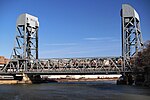John F. Kennedy High School (New York City)

John F. Kennedy High School is a former four-year comprehensive New York City public high school, located at 99 Terrace View Avenue along the border of the Spuyten Duyvil section of the Bronx and the Marble Hill neighborhood of Manhattan, near the Kingsbridge section of the Bronx. The building currently operates as John F. Kennedy Educational Campus, housing four small public high schools and two charter high schools. The campus serves grades 9–12 and is operated by the New York City Department of Education.JFK High school is known as one of the most successful Public Schools Athletic programs in New York City. The male sports teams' mascot is the Knight and the female's is the Flame. The school has won 37 Public Schools Athletic League championships as of 2011, including titles in basketball, football, volleyball, gymnastics, and track and field.Notable alumni includes American politicians, hip-hop legends and a number of professional sport stars.
Excerpt from the Wikipedia article John F. Kennedy High School (New York City) (License: CC BY-SA 3.0, Authors, Images).John F. Kennedy High School (New York City)
Terrace View Avenue, New York Manhattan
Geographical coordinates (GPS) Address Nearby Places Show on map
Geographical coordinates (GPS)
| Latitude | Longitude |
|---|---|
| N 40.8775 ° | E -73.913611111111 ° |
Address
Bronx Theatre High School
Terrace View Avenue 99
10463 New York, Manhattan
New York, United States
Open on Google Maps







